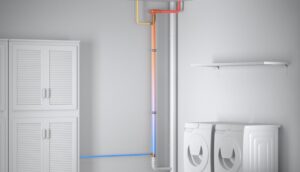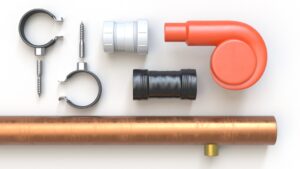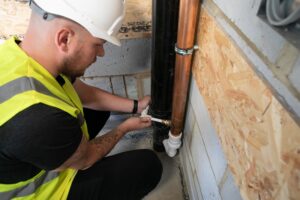
Tony Gordon, Managing Director at Showersave, outlines why shower waste water heat recovery should be on every builder’s radar
As the 2025 Future Homes Standard deadline approaches, SME builders are under growing pressure to deliver homes that meet new energy efficiency targets. That means low-carbon heating is no longer just a selling point – it’s becoming the baseline. And for most new homes, air source heat pumps (ASHPs) will be the default solution.
Heat pumps are an excellent choice for space heating in well-insulated homes, but hot water performance remains a common challenge. In busy households, peak demand from showers and baths can quickly expose the limits of a standard system. The usual solution is to upsize the hot water cylinder or add immersion top-ups – both of which increase running costs, use up valuable space and compromise overall efficiency.
There’s a smarter, simpler solution that not enough people are talking about. Waste water heat recovery for showers (WWHRS) is a passive system that recovers heat from the warm water going down the drain and uses it to preheat the incoming cold mains supply. That preheated water can then feed into the hot water cylinder or go directly to the shower mixer, depending on the system design. The result? Less energy needed to heat water, quicker cylinder recovery times and reduced reliance on electric back-up.
Unlike many of the newer technologies arriving on the market, WWHRS is straightforward to install using standard plumbing techniques. It requires no electricity, has no moving parts and doesn’t need any end-user interaction or regular maintenance. For small and medium-sized building companies, it’s a low-risk, high-reward option that can slot easily into both new build and retrofit projects.

To put the technology to the test, Showersave recently commissioned independent research carried out by energy expert Chris Martin (formerly of the Energy Monitoring Company) in partnership with the Centre for Sustainable Technologies at Ulster University. The results showed exactly how effective WWHRS can be when paired with ASHPs.
In homes without WWHRS, households experienced cold water by the fourth consecutive shower – not ideal for families. With WWHRS installed, hot water availability was extended, helping to avoid that frustrating cold shock and reduce the chances of customer complaints after handover.
Even more importantly, the system cut electricity use for hot water by 31-36 per cent in standard operation, and by up to 47 per cent when immersion back-up was being used. That translates to a potential saving of £150-£200 per year on energy bills for a typical four-person household – something that’s becoming increasingly important for homebuyers amid ongoing cost-of-living pressures.

Recovery times were also significantly improved, with cylinders taking around half the time to heat up compared to systems without WWHRS. That not only improves performance but can also open up the possibility of specifying smaller cylinders – saving space and reducing equipment costs.
From a compliance point of view, WWHRS is already included in the notional specification for Option 1 of the Future Homes Standard, and it’s fully recognised in SAP with reliable performance data. It’s also certified as a Passive House component and has a very low embodied carbon footprint, making it an excellent fit for sustainability-driven projects.
Builders working at the sharp end of domestic construction know the importance of systems that work well in the real world. Hot water issues are a common cause of post-completion call-backs, and even if a home ticks all the compliance boxes on paper, that won’t matter if a family can’t run back-to-back showers without problems. By integrating WWHRS, you can help to avoid those issues before they arise.

It’s also a compelling addition for merchants and heating engineers looking to add value to heat pump packages. With demand for heat pumps growing rapidly, solutions that enhance overall performance and user experience – without adding complexity – are likely to become increasingly sought after.
For SME builders, the advantages are clear. WWHRS is easy to install, requires no specialist training, and delivers immediate, measurable benefits to hot water systems. It improves customer satisfaction, reduces energy use, and supports compliance – all without increasing build complexity.
As we head towards a future where every new home must operate with low-carbon systems, simple technologies like WWHRS will play an important role in bridging the gap between efficiency targets and practical, everyday performance.
Showersave brought WWHRS to the UK in 2008 and has since installed over 200,000 systems across the UK and Europe. Every unit is fully recyclable and backed by a dedicated technical support team that can provide advice on design integration, installation and compliance.
To find out more about Showersave click here
